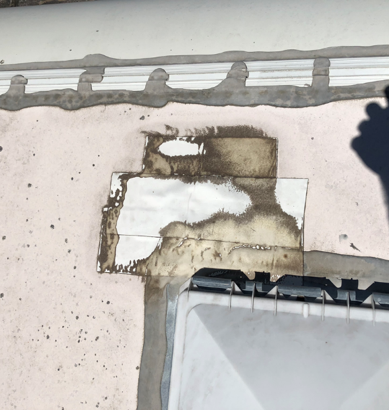
Single-ply roof membranes are made out of plastic or rubber materials.
The most common types are:
- EPDM (ethylene propylene diene monomer) rubber roof membranes,
- PVC roof membranes, and
- TPO (thermoplastic polyolefin) roof membranes.
Their thicknesses can vary from 40 mils to 80 mils.
Single-ply roof membranes are commonly used on:
- commercial buildings,
- residential flat roofs, and
- RVs, campers, and trailers.
The Cheapest Way to Repair a Leak is By Using Tapes.
These roofing materials are susceptible to punctures, tears, and other damage. Water can gain ingress through seams and penetrations when they are not detailed properly.
When damage or leaks develop, the simplest and most effective remedy is to seal the area with a self-adhesive tape designed to repair roof leaks.
Repairs using tapes are very economical. However, selecting a poor-quality tape can be costly if a premature failure occurs.
Reasons to Consider Using Only High-quality Waterproofing Tapes.
All waterproofing tapes are not created equal. When comparing tapes, one of the most overlooked physical attributes of a tape is the thickness of the backing.
>The backing (the part of the tape exposed to the elements after installation) protects the sealant adhesive from physical damage and UV (ultraviolet). UV rays and weather can cause the backing to slowly break down and fail in some tapes. This, in turn, causes the adhesive to degrade quickly. These failures are usually not detected until water leakage has already done damage, resulting in costly repairs. Also, thicker backings provide added protection from abrasion, punctures, and UV damage.
Lastly, compatibility with existing sealants, ponding water, and adhesion to the single-ply membrane should also be considered. Incompatibility and ponding water can cause a chemical breakdown of the tape. Poor adhesion will ultimately result in delamination of the tape.
Also read: The Best Waterproofing Tape in The Market is 4EvaSeal® - Study Shows
The Competition vs. 4EvaSeal

Photo 1- Failed Competitor Tape
The photo above shows how adverse conditions can present themselves on a travel trailer. The picture displays a widely known brand tape that is quickly deteriorating after only 3 years of exposure.
The combination of UV, incompatibility with the sealant, and occasional ponding are rapidly breaking down the tape.
4EvaSeal Waterproofing Tape

Photo 2- 4EvaSeal Waterproofing Tape
Photo 2 shows the same travel trailer, but in this instance, the skylights were sealed with 4EvaSeal during the same time period as the failed tape above. The thicker 4EvaSeal tape is not exhibiting any signs of premature failure and still maintains its brilliant white appearance. The same sealant can be found below the 4EvaSeal, and there is no evidence of incompatibility with the tape.
As Seen on TV Flexible Waterproofing Tapes
These retail tapes use exceptionally thin backings and adhesives to meet very low retail price points. While as Seen on TV ads may lead you to believe the tapes are “miracle” products, the fine print clearly states that these tapes are meant only for “temporary emergency repairs.” While the cost per roll may initially appear to be low, the rolls of tape contain very little actual material, and the cost per square foot of product is much higher than high-quality repair tapes.
Typically, the backings of As Seen on TV types of tape are not UV stable or are not intended to be left exposed for long periods of time. They use asphalt or acrylic adhesives that can liquify, wear down in water, and break down when exposed.
Here are some final recommendations.
Make sure the waterproofing tape selected for the repair is suitable for use on your single-ply roof membrane, is UV stable, and is designed to provide a long-term watertight seal when exposed to wet conditions. Use a high-quality product like 4EvaSeal.
You can always contact us if you need more information.






